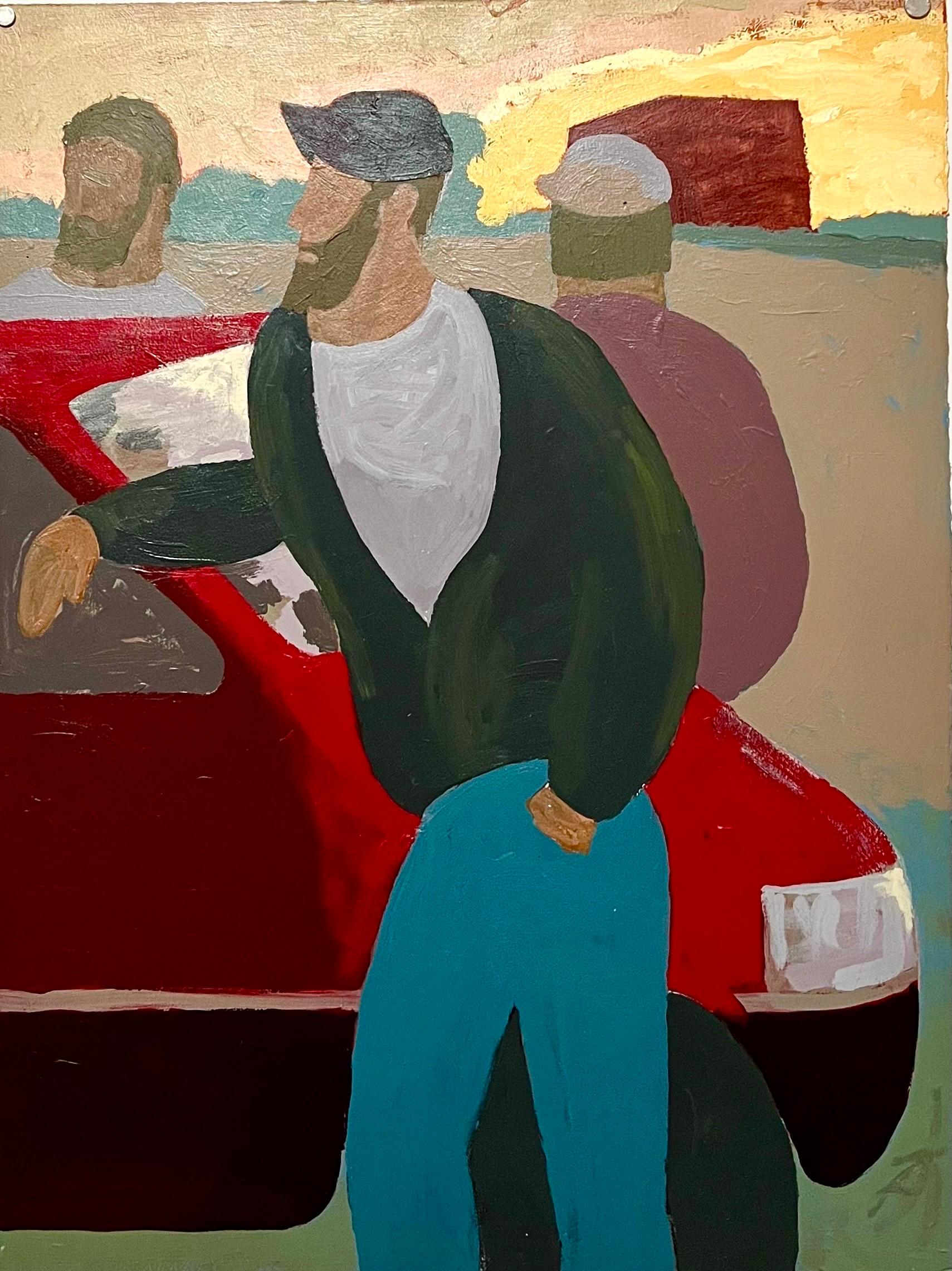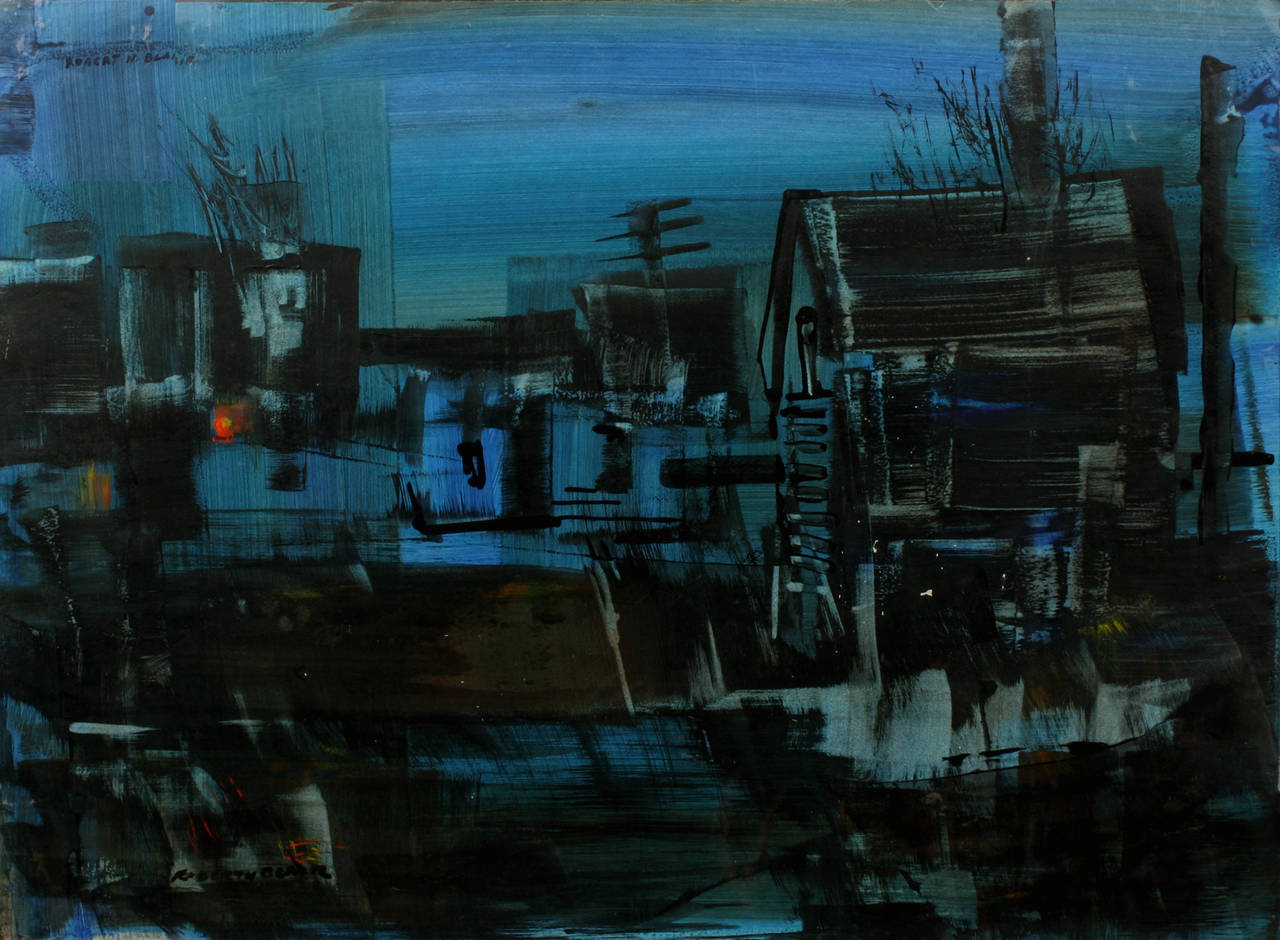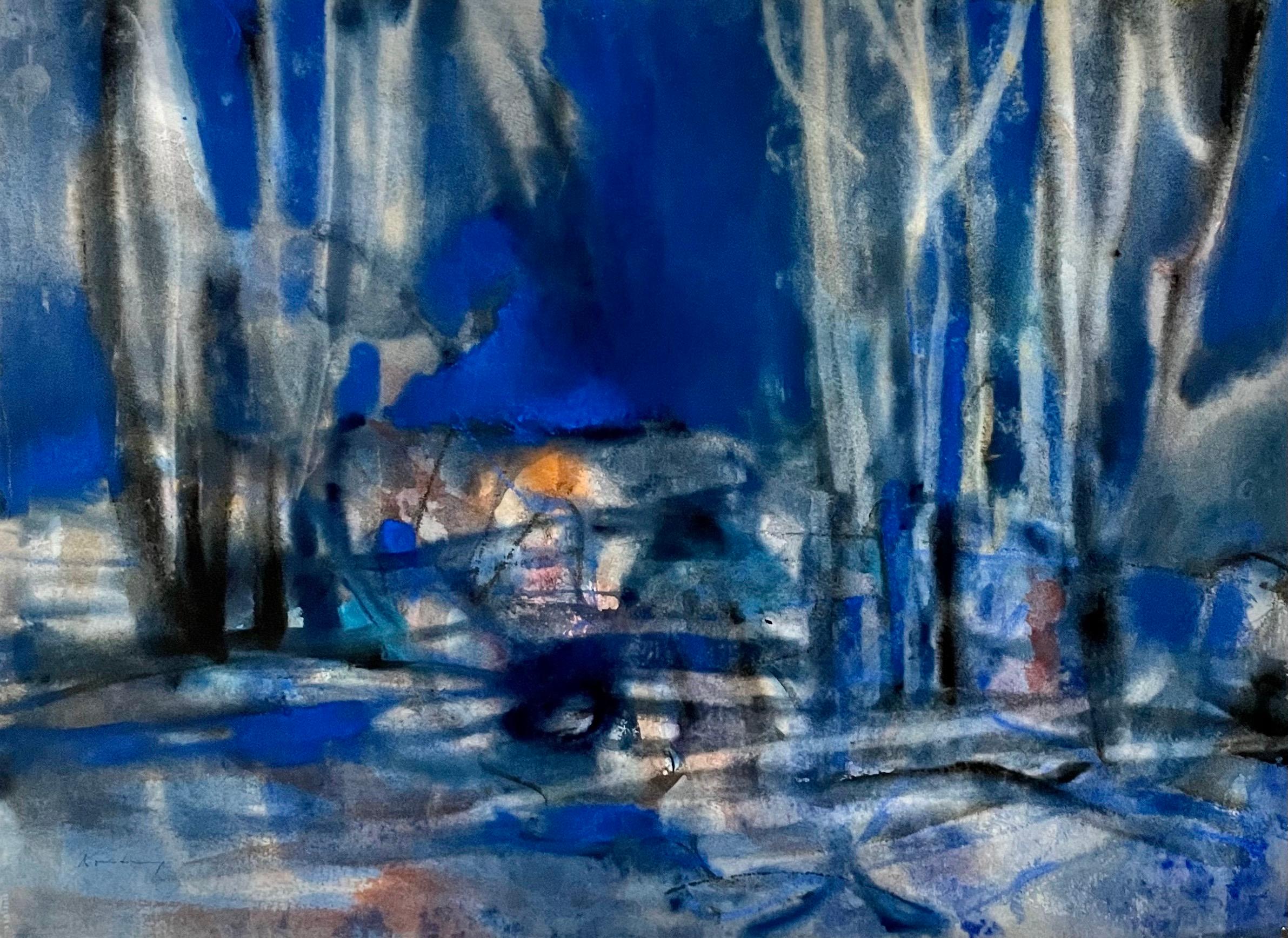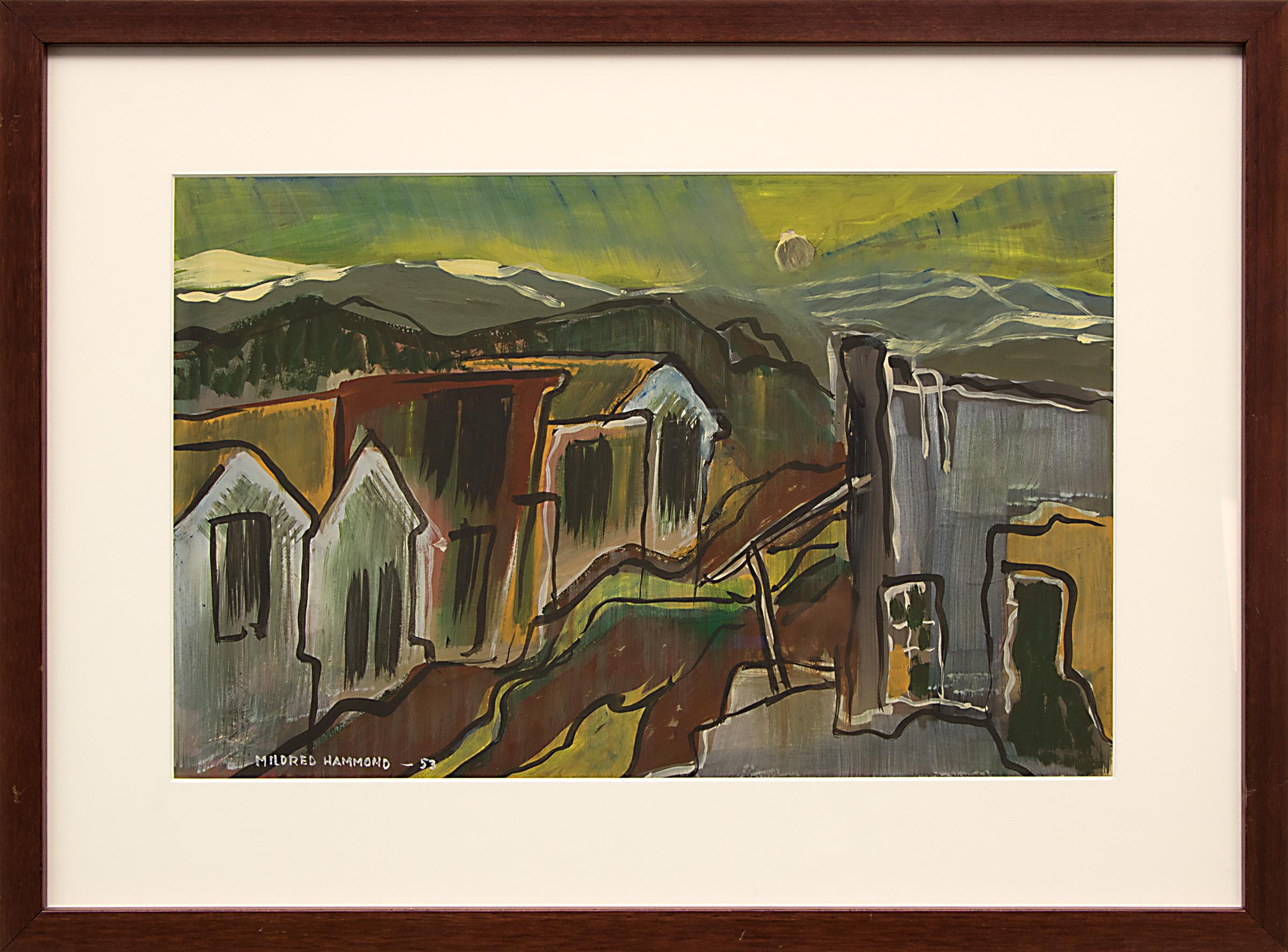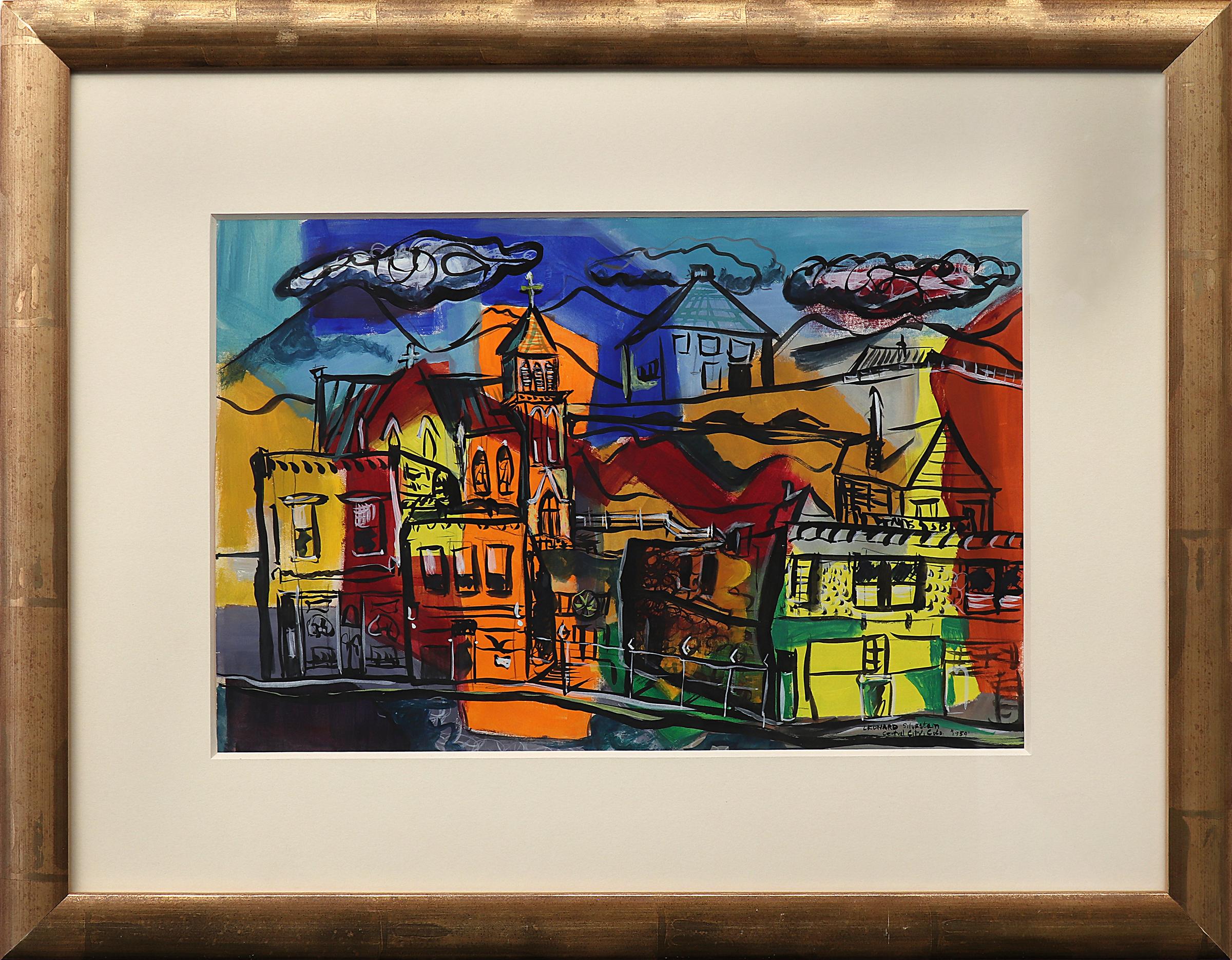Items Similar to Fitzhugh Mine, near Leadville, Colorado, Mountain Mining Landscape Oil Painting
Video Loading
Want more images or videos?
Request additional images or videos from the seller
1 of 13
Eldora Pauline LorenziniFitzhugh Mine, near Leadville, Colorado, Mountain Mining Landscape Oil Painting1937
1937
About the Item
Oil on mounted paper, Colorado modern mountain landscape painting by early 20th Century female artist, Eldora Pauline Lorenzini (1910- 1993) from 1937. Painting depicts Fitzhugh Mine, near Leadville, Colorado. Signed and dated by the artist in the lower right corner. Presented in a vintage frame, outer dimensions measure 13 ½ x 16 x ¾ inches. Image size is 11 ¼ x 13 ½ inches.
Expedited and international shipping is available - please contact us for a quote.
- Creator:Eldora Pauline Lorenzini (1910 - 1993, American)
- Creation Year:1937
- Dimensions:Height: 13.5 in (34.29 cm)Width: 16 in (40.64 cm)Depth: 0.75 in (1.91 cm)
- Medium:
- Movement & Style:
- Period:
- Framing:Frame IncludedFraming Options Available
- Condition:very good condition.
- Gallery Location:Denver, CO
- Reference Number:
About the Seller
5.0
Platinum Seller
These expertly vetted sellers are 1stDibs' most experienced sellers and are rated highest by our customers.
Established in 1979
1stDibs seller since 2013
265 sales on 1stDibs
Typical response time: 3 hours
- ShippingRetrieving quote...Ships From: Denver, CO
- Return PolicyA return for this item may be initiated within 7 days of delivery.
More From This SellerView All
- Mill Near Plainfield, New Hampshire, Landscape Painting, Charles Partridge AdamsBy Charles Partridge AdamsLocated in Denver, CO"Mill Near Plainfield, New Hampshire" is an original, signed watercolor painting by artist Charles Partridge Adams (1858-1942), circa 1900. Singed by the artist in the lower left corner. Portrays a mill along a river with trees and clouds, painted in shades of brown, green, gray, and blue. Presented in a custom frame, outer dimensions measure 13 ¾ x 12 ¼ x 1 ¼ inches. Image size is 7 x 5 inches. Expedited and international shipping is available - please contact us for a quote. About the Artist: Born Massachusetts, 1858 Died 1942 Born in Franklin, Massachusetts, Charles Partridge Adams moved with his mother and two sisters to Denver, Colorado, in 1876 in an effort to cure the two girls who suffered from tuberculosis. In Denver, Adams found work at the Chain and Hardy Bookstore. He received his first, and only, art training from the owner's wife, Helen Chain. Mrs. Chain, a former pupil of George Inness, provided instruction and encouragement to the young artist and introduced him to other artists in the area including Alexander Phimister Proctor...Category
20th Century American Modern Landscape Drawings and Watercolors
MaterialsWatercolor, Archival Paper
- Cripple Creek Colorado, 1950s American Modern Landscape Painting, Green BrownLocated in Denver, CO1950s gouache on paper painting signed by artist Mildred Welsh Hammond (1900-1980) portraying a modernist view of Cripple Creek, Colorado with the town ...Category
1950s American Modern Landscape Paintings
MaterialsGouache, Archival Paper
- Central City, Colorado, 1950s Semi-Abstract Cityscape Gouache Painting, Red BlueLocated in Denver, CO'Central City, Colorado' by Leonard Silverstein is an original gouache on paper from 1954. Hand signed, titled, and dated by the artist in the lower right...Category
1950s American Modern Landscape Paintings
MaterialsGouache, Archival Paper
- Colorado Mountain Winter Landscape Watercolor Painting, Blue, Orange, PurpleLocated in Denver, COColorado mountain landscape watercolor painting signed by artist Rita Derjue (1934-2020) depicts Cabins in the Snow in bright tones of blue, yellow, green and red/brown. Signed by the artist in the lower right corner. Presented in a custom frame with archival materials, outer dimensions measure 24 ⅛ x 31 ½ x 1 ¼ inches. Image sight size is 14 ½ x 21 ½ inches. About the Artist: Born Rhode Island, 1934 Artist, educator, mentor and community activist, Derjue is the daughter of European parents whose family members had previous connections with New York and New England. Her drawing talent as a youngster in Rhode Island caught the attention of family friend Johann Groen, a Dutch-born painter and photographer, who encouraged her to spend time touring and studying in Europe to further her art education. In 1956 she earned her Bachelor of Fine Arts degree at the Rhode Island School of Design that emphasized the fundamentals of drawing and design. Her most memorable teacher was Richard Hamilton, whose work was influenced by German Expressionist Max Beckmann and the jazz greats. Her studies from nature and Cubist compositions done at that time reflect her interest in early twentieth-century European modernist painting. She had the opportunity to experience it firsthand during a year of post-graduate work at the renowned Akademie den Bildenden Kunste in Munich, Germany, in 1956-57. She studied with Ernest Geitlinger (1895-1972) whom the Nazi government classified as a “degenerate” artist in the 1930s, preventing him from exhibiting in Germany. After World War II he was one of the co-founders of the Munich artists’ association, Neue Gruppe, in 1946 and played an important role in abstract painting. While studying with him in Munich she produced a number of canvases in a referential abstract style. She also became acquainted with the Blaue Reiter group that flourished in the early twentieth century and whose expressionism strongly influenced her color palette and painting style. She particularly admired the work of Blaue Reiter co-founder and Wassily Kandinsky’s long-time partner, Gabriele Münter, whose work she studied at the Lenbachhaus in Munich and at the Gabriele Münter Haus and the Schlossmuseum in Murnau south of Munich. Derjue’s immersion in German Expressionism imparted a bold, simplified style to her work. In 1958 with a friend from Munich she went to Mexico for a year, studying with artist Frank Gonzalez in his studio in San Angel, Mexico City, and with Canadian artist, Toni Onley, in San Miguel de Allende. Onley had recently won a scholarship to the Instituto Allende to study mural and fresco painting with David Siqueiros, one of the three greats of Mexican muralism. At the Instituto Onley began painting large black-and-white canvases in an abstract impressionistic style which he imparted to Derjue, who thereafter began exploring color and space in the dimensions of her own large compositions. With writer Gregory Strong, he subsequently published Onley’s Arctic and his autobiography, The Tony Onley Story. After returning to the United States, she worked as a graphic designer for Little, Brown and Company, publishers in Boston. She began dating her future husband, Carle Zimmerman, whom she met earlier in Europe and whom she married in 1960. Joining him at Cornell University where he was completing his Ph.D degree, she earned her Master of Arts degree at the same institution and participated in group shows at the Herbert F. Johnson Museum and the Munson-Williams-Proctor Arts Institute in upstate New York. In 1963 Derjue and her husband relocated to Littleton, Colorado, where he spent his entire career, first as a research engineer and later as a departmental manager for the Marathon Oil...Category
20th Century American Modern Landscape Paintings
MaterialsWatercolor, Archival Paper
- 1940s Colorado Mountain Landscape Gouache Painting with Snow, Trees, and TrainLocated in Denver, COAmerican modern 1945 winter landscape painting by Edgar Britton (1901-1982) with a tree driving among snowy mountains and trees (likely Colorado). Signed and dated by the artist in t...Category
1940s American Modern Landscape Paintings
MaterialsGouache, Archival Paper
- Spring Storm, Modernist Southwestern New Mexico Landscape Casein PaintingBy Doel ReedLocated in Denver, COSpring Storm, original vintage painting by New Mexico & Oklahoma modernist, Doel Reed (1894-1985). Evening scene with hint of a moon, clouds and rain over a rocky western landscape with low mountains/buttes, dated, June 1980 and signed by the artist lower right. Presented in a custom frame, outer dimensions measure 24 ½ x 37 ½ x 1 ¼ inches. Image size is 14 ¾ x 27 ¾ inches. Provenance: Private Collection, Denver, Colorado Expedited and international shipping is available - please contact us for a quote. About the Artist: Early in his artistic career, Doel Reed knew he wanted to be a printmaker. Influenced by Goya's aquatints, he extended himself beyond his formal art training to learn this technique, and he established himself as one of its masters. For decades, he devoted himself to the art program at the University of Oklahoma, taking it from a faculty of one to a major mid-Western department. Upon retirement, Reed focused totally on his work, moving with his family to Taos, New Mexico, where they had previously summered. Marked by strong tonal contrasts, his landscapes of this region are deeply emotional renderings with a sense of mystery -- modernist forms combined with romantic moodiness. Born and raised in Indiana, Reed originally studied architecture, which he credits with a lifelong attention to "how something is constructed." His mature style can be characterized as architectonic in his concern with assembling volumes and planes. Even the intense northern New Mexico light becomes the means to articulate three-dimensional patterns into cubistic interplay. When painting, Reed used thick strokes of oil and casein as another structural element. Transferring to fine art, his studies at the Cincinnati Art Academy were then interrupted by military service in World War I. Suffering a gas attack in the trenches of France, Reed spent months in a hospital temporarily blinded. The effects of the gas also damaged his lungs, which later prompted him to live in the dry climates of Oklahoma and New Mexico. After the war, he returned to his studies, but it was discovery of Goya's aquatints rather than his art classes that inspired. Considered the master, Goya drew on the tonal range available with this medium to create powerfully haunting imagery. Perhaps Reed responded personally to the eloquent series "The Disasters of War." Now his course was set, and he built his own etching press, which he continued to use for the rest of his life. In 1924, he accepted a teaching position at Oklahoma State University, where he remained for thirty-five years. Emphasizing drawing, Reed encouraged students to go to nature and translate the scene through their own sensibilities. Beginning as the sole art professor, he developed the program when it became an independent department in 1930. Through his stewardship, the university gained a reputation as one of the best for printmaking in the country. During the forties, Reed also prepared a series of lectures and demonstrations on aquatint for the Association of American Colleges. His most public offering in art education is the book "Doel Reed Makes An Aquatint" (1965). Sabbaticals allowed him to visit Paris in 1926 and 1930-31. Summer travel took him to Nova Scotia and Mexico, but gas rationing during World War II necessitated a closer destination. Thus the Reed connection with Taos was established. Finally in 1959, he, his wife, and daughter moved there to Talpa Ridge, the same outlying area in which artists like Andrew Dasburg, Howard Cook, and Barbara Latham resided. Settling into a complex of three adobe buildings, Reed was welcomed by these artists, who referred to their community as Neurosis Ridge. Rena Rosenquist of Mission Gallery remembers that Reed was "the most affable man" who liked cold martinis. For Reed, the surrounding Sangre de Cristo Mountains offered "end of abstract pattern." His inventive mind came up with techniques to transform a natural scene into a richly dimensional object. He fashioned a rosin box and concocted his own formula of etching ground to achieve a velvety texture with his prints. Described as "not for the faint-hearted,”" casein became a medium with which built up paint surfaces that almost seem sculpted. Both the prints and drawings are characterized by a tension between the two-dimensional surface pattern and the articulated space it conveys. In addition to landscapes, Reed produced a number of works of voluptuous women with the figures echoing landscape elements. As a boy, his first art experience was a grade-school field trip to the John Herron Art Museum (now the Indianapolis Art Museum), where he expressed his admiration for a painting of a nude mermaid -- an image that made a lasting impression. Reed was proudest of his recognition by the National Academy of Design (now just the National Academy). In 1942, he was named associate member; in 1952, he was named full academician. ©David Cook Galleries, LLC Exhibited: Society of Independent Artists, 1927 & 1929; Society of American Etchers, 1930-1946; Kansas City Art Institute, 1932; “100 Etchings of Year,” 1932-44; Art Institute of Chicago, 1934, 1937, 1939; National Academy of Design, 1934-46, 1965 (Samuel Morse Medal); Tulsa Art Association, 1935 (prize); Paris Salon, 1937; Rome, Italy, 1937; Sweden, 1938; Chicago Society of Etchers, 1938 (prize); Corcoran Gallery of Art, Washington, D.C., 1940; Philadelphia Print Club, 1940 (prize); Venice, Italy, 1940; Carnegie Institute, 1941; Currier Gallery of Art, Manchester, NH,1942, (prize); Metropolitan Museum of Art, 1942; Whitney Museum of American Art, 1942; Northwest Printmakers, 1942 (prize), 1944 (prize); Herron Art Institute, 1943; Library of Congress, 1944-46; Pennsylvania Academy of the Fine Arts, 1944-45; Philbrook Art Club, 1944 (prize); Laguna Beach Art Association, 1944 (prize); Southern States Art League, 1944 (prize); “50 American Prints,” 1944; Oakland Art Gallery, 1945 (prize); Audubon Artists, 1945, 1951 (Gold Medal of Honor), 1954 (John Taylor Arms Memorial Medal); Albany Institute of History and Art, 1945; Pasadena Art Institute, 1946; London; Allied Art Association; National Society of Painters Casein; Mission Gallery, Taos, NM, and Blair Galleries, Ltd. Santa Fe, NM. Works Held: Carnegie Institute; Honolulu Academy of Art; Grinnell College; Library of Congress; Metropolitan Museum of Art; Museum of Fine Art, Houston; New York Public Library; Oklahoma Art Club; Pennsylvania Academy of Fine Art; Philadelphia Museum of Art; Philbrook Art Club; Seattle Art Museum; Southern Methodist University; University of Montana; University of Tulsa; Bibliotéque Nationale, Paris; Victoria and Albert Museum, London. Further Reading: Harmsen's Western Americana: A Collection of One-Hundred Western Paintings with Biographical Profiles of the Artists, Dorothy Harmsen, Northland Press, Flagstaff, Arizona, 1971.; The Illustrated Biographical Encyclopedia of Artists of the American West, Peggy and Harold Samuels, Doubleday & Company, Inc., Garden City, New York, 1976.; Taos Artists...Category
1980s American Modern Landscape Paintings
MaterialsCasein, Archival Paper
You May Also Like
- Large Hudson River Figurative Modernist Landscape Oil Painting Edward AvedisianBy Edward AvedisianLocated in Surfside, FLEdward Avedisian ( 1936-2007 ) Gouache or oil on paper, 3 guys around a car, hand signed in paint lower left, Measures 30"x 22.5" Edward Avedisian (June 15, 1936, Lowell, Massachusetts – August 17, 2007, Philmont, New York) was an American abstract painter who came into prominence during the 1960s. His work was initially associated with Color field painting and in the late 1960s with Lyrical Abstraction and Abstract Expressionism. He studied art at the School of the Museum of Fine Arts, Boston. By the late 1950s he moved to New York City. Between 1958 and 1963 Avedisian had six solo shows in New York. In 1958 he initially showed at the Hansa Gallery, then he had three shows at the Tibor de Nagy Gallery and in 1962 and 1963 at the Robert Elkon Gallery. He continued to show at the Robert Elkon Gallery almost every year until 1975. During the 1960s his work was broadly visible in the contemporary art world. He joined the dynamic art scene in Greenwich Village, frequenting the Cedar Tavern on Tenth Street, associating with the critic Clement Greenberg, and joining a new generation of abstract artists, such as Darby Bannard, Kenneth Noland, Jules Olitski, and Larry Poons. Avedisian was among the leading figures to emerge in the New York art world during the 1960s. An artist who mixed the hot colors of Pop Art with the cool, more analytical qualities of Color Field painting, he was instrumental in the exploration of new abstract methods to examine the primacy of optical experience. One of his paintings was appeared on the cover of Artforum, in 1969, his work was included in the 1965 Op Art The Responsive Eye exhibition at the Museum of Modern Art and in four annuals at the Whitney Museum of American Art. His paintings were widely sought after by collectors and acquired by major museums in New York and elsewhere. He has been exhibited in prominent galleries, such as the Anita Shapolsky Gallery and the Berry Campbell Gallery in New York City. Edward Avedisian was known for his brightly colored, boldly composed canvases that combined Minimalism's rigor, Pop art exuberance and the saturated tones of Color Field painting. Roberta Smith of the NYT writes of Avedesian: "Edward Avedisian helped establish the hotly colored, but emotionally cool, abstract painting that succeeded Abstract Expressionism in the early 1960s. This young luminary harnessed elements of minimalism, pop, and color field painting to create prominent works of epic proportions that energized the New York art scene of the time." In 1996 Avedisian showed his paintings from the 1960s at the Mitchell Algus Gallery, then in SoHo. His last show, dominated by recent landscapes, was in 2003 at the Algus gallery, now in Chelsea. Selected Exhibitions: Op Art: The Responsive Eye, at the Museum of Modern Art, Whitney Museum’s Young America 1965 Expo 67, held in Montreal, Canada. Six Painters (along with Darby Bannard, Dan Christensen, Ron Davis...Category
20th Century American Modern Landscape Paintings
MaterialsOil, Gouache, Archival Paper
- Shanty TownBy Robert Noel BlairLocated in Buffalo, NYYou are viewing a modernist American acrylic painting depicting a charming but rundown seaside town at night. Robert Noel Blair (American, 1912-2003) was an American artist, paint...Category
1950s American Modern Landscape Paintings
MaterialsAcrylic, Archival Paper
- Large Modernist Abstract Expressionist Gouache Painting Bauhaus Weimar ArtistBy Pawel KontnyLocated in Surfside, FLAbstract watercolor or gouache composition bearing the influence of the earlier color-block compositions of Paul Klee. Pawel August Kontny, (Polish-German-American artist) He was born in Laurahuette, Poland, in 1923, the son of a wealthy pastry shop owner. In 1939 he began studying architecture in Breslau where he was introduced to the European masters and to the work of some of the German Expressionists, soon afterward banned as "degenerate artists" and removed from museums throughout Germany by the Nazi regime. His studies were interrupted by World War II. Drafted into the German army, traveling in many countries as a soldier, he sketched various landscapes but in 1945, he was captured and held as a prisoner of war in Italy. After the war, he studied at the Union of Nuremberg Architects to help design buildings to replace ones destroyed in the war. He recorded his impressions of the local population and the landscapes through his watercolors and drawings. Pawel Kontny thereafter moved to Nuremberg, Germany, becoming a member of the Union of Nuremberg Architects and helping to rebuild the city's historic center. He soon decided to concentrate on his professional art career. He married Irmgard Laurer, a dancer with the Nuremberg Opera. Pavel Kontny 's career as an artist was launched with his participation in an all German exhibition, held at the Dusseldorf Museum in 1952. He held one-man shows in Germany, Switzerland and the United States. During his trip to the United States in 1960, Kontny became instantly enamored with Colorado, and decided to relocate to Cherry Hills with his wife and two children. He quickly established himself in the local art community, being affiliated for a time with Denver Art Galleries and Saks Galleries. His subject matter became the Southwest. During this time he received the Prestigious Gold Medal of the Art Academy of Rome. His extensive travel provided material for the paintings he did using his hallmark marble dust technique. he also worked equally in pastel, watercolor, charcoal and pencil-and-ink. in a style which merged abstraction and realist styles, influenced by Abstract Expressionist painting and South Western American landscapes. In the early 1960s he was one of only a few European-born professional artists in the state, a select group that included Herbert Bayer (1900-1985), a member of the prewar Bauhaus in Weimar and Dessau, Germany, and Roland Detre (1903-2001), a Hungarian modernist painter. As a Denver, Colorado resident, Pavel Kontny exhibited at galleries and museums throughout the United States, Germany and Japan. There, he was inspired by frequent trips to Native American pueblos in the Southwest, as well as by the study of the Plains Indians of Montana and Wyoming. Over the years Kontny had a number of students and generously helped young artist by hosting exhibitions at his Cherry Hills home. For many years he generously donated his paintings to support charitable causes in Denver. Influences during his European years included German pastelist C.O. Muller, German Informel painter Karl Dahmen and Swiss artist, Hans Erni. In the early 1950s his painting style showed the influence of the Die Brücke (The Bridge), a group of German expressionist artists formed in Dresden in 1905 who had a major impact on the evolution of modern art in the twentieth century in Germany. By the middle of the decade his style incorporated more referential abstraction and total abstraction, resulting in part from his study of Hans Hartung, a German artist based in Paris who exhibited his gestural abstract work in Germany. The American moon landing in 1969 inspired Paul Kontny...Category
20th Century American Modern Landscape Paintings
MaterialsWatercolor, Archival Paper
- Society of Six Street Scene - Figurative AbstractBy Bernard Von EichmanLocated in Soquel, CAStunning New York City urban modernist watercolor titled "Summer Afternoon Stroll" by Society of Six artist Bernard Von Eichman (American, 1899-1990), 1...Category
1930s American Modern Landscape Paintings
MaterialsArchival Paper, Watercolor
- Early 20th Century California Industrial Scene LandscapeBy Erle LoranLocated in Soquel, CAVibrant California modernist industrial landscape by Erle Loran (American, 1905-1999). Signed and dated lower left "Erle Loran '37." Presented in a gilt wood frame, with faux suede liner, giltwood fillet and off white archival mat. Image, 15”H x 19”L. Erle Loran was born in Minneapolis, Minnesota. He studied at the Minneapolis School of Art under the direction of Cameron Booth...Category
1930s American Modern Landscape Paintings
MaterialsWatercolor, Gouache, Archival Paper
- 1, 000 piece Museum Quality Collection of Art & Objects from NYC 1939 Worlds FairBy Harry LaneLocated in New York, NY1,000 piece Museum Quality Collection of Art & Objects from NYC 1939 Worlds Fair Harry Lane (1891-1973) "1939 World’s Fair Construction," 30 x 40 inches, Oil on canvas, signed lower...Category
1930s American Modern Landscape Paintings
MaterialsCanvas, Photographic Paper, Plaster, Oil
Recently Viewed
View AllMore Ways To Browse
Framed Landscape Painting Mountains
Colorado Landscapes
Colorado Landscape Art
Female Landscape Artist
Colorado Oil Painting
Colorado Landscape Paintings
Colorado Artists Landscapes
Vintage Landscape Oil Painting
Vintage Mountain Art
Vintage Oil Painting Art Landscape
Colorado Mountains
Archive Early 20th Century Paintings
American Female Landscape Paintings
Colorado Mountains Painting
Mining Art
Colorado Mountain Landscapes
Vintage Colorado Signs
American 20th Century Colorado
